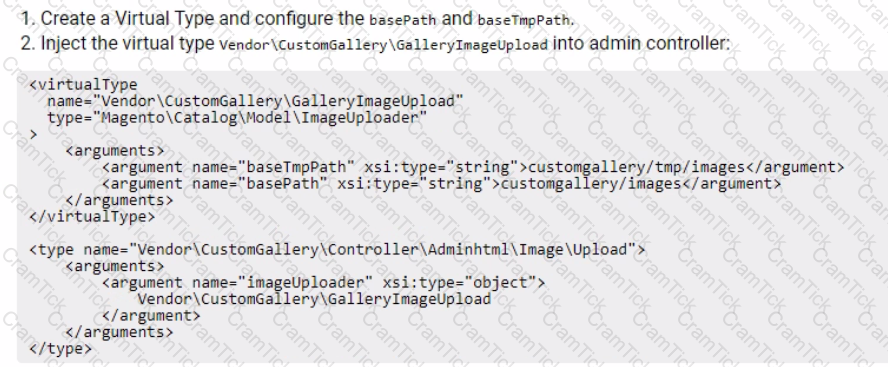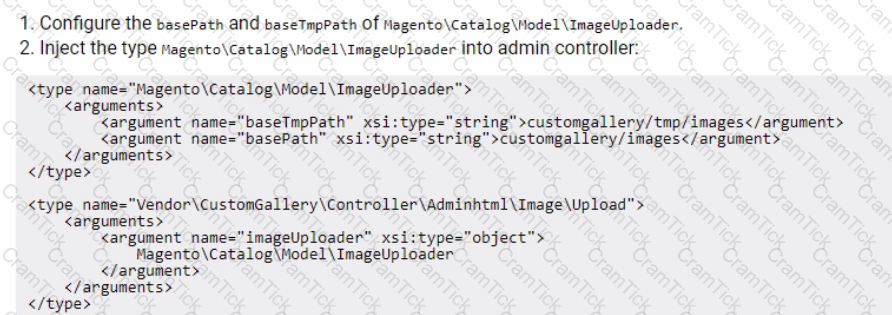An Adobe Commerce developer is asked to create a new payment method for their project. This project has administrators who use the backend to manage customer information and occasionally place orders. When testing the new payment method on the frontend everything worked as expected, however, the payment method is missing in the admin.
What is a possible reason for this?
When attempting operations that require lengthy processing, a merchant on Adobe Commerce Cloud receives a timeout error after 180 seconds.
How would the developer deal with this issue?
How would a developer turn on outgoing emails on an Adobe Commerce Cloud Staging environment?
An Adobe Commerce Cloud project is using Enhanced Integration Environments with two install a new payment module.
The developer is using Cloud CLI for Commerce tool.
What would a developer do to test this new feature under the integration environment?
There is an integration developed using a cron service that runs twice a day, sending the Order ID to the integrated ERP system if there are orders that are able to create an invoice. The order is already loaded with the following code:
$order = $this->orderRepository->get($orderId);
In order to verify if the store has invoices to be created, what implementation would the Adobe Commerce developer use?
A)

B)

C)

An Adobe Commerce developer is working on a Magento 2 instance which contains a B2C and a B2B website, each of which contains 3 different store views for English, Welsh, and French language users. The developer is tasked with adding a link between the B2C and B2B websites using a generic link template which is used throughout the sites, but wants these links to display in English regardless of the store view.
The developer creates a custom block for use with this template, before rendering sets the translate locale and begins environment emulation using the following code:

They find that the template text is still being translated into each stores language. Why does this occur?
An Adobe Commerce developer is working on a custom gallery extension.
The module uses the Magento\catalog\Model\iinageUploader class for image uploading. The admin controller for custom image uploads is Vendor\CustomGallery\Controller\Adminhtml\Image\Upload.
The images need to be stored in different basePath and baseTmpPath than the default ones.
How can the default imageuploader class be extended and used without affecting the other modules that are already using it?
A)

B)

C)

An Adobe Commerce developer creates a new website using a data patch. Each website will have unique pricing by website. The developer does not have visibility into the production and staging environments so they do not know what the configuration currently is.
How would they ensure the configuration is deployed and consistent across all environments?
A)

B) 
C)

An Adobe Commerce Developer has written an importer and exporter for a custom entity. The client is using this to modify the exported data and then re-importing the file to batch update the entities.
There is a text attribute, which contains information related to imagery in JSON form, media_gallery. This is not a field that the client wants to change, but the software they are using to edit the exported data seems to be modifying it and not allowing it to import correctly.
How would the developer prevent this?
A) Specify a serializer class for the attribute using the $_transformAttrs class property array for both the exporter and importer so it gets converted:

B) Strip the attribute from the imported file by adding it to the s_strippedAttrs class property array:

C) Prevent it from being exported by adding it to the $_disat>iedAttrs class property array:

An Adobe Commerce developer is about to deploy a critical feature to their Adobe Commerce Cloud (Pro Plan) production. They want to create a snapshot in order to be able to rollback if there is an issue with the feature.
How would they create the snapshot?
An Adobe Commerce developer has created a process that exports a given order to some external accounting system. Launching this process using the Magento CLI with the command php bin/magento my_module:order: process --order_id=
Example: php bin/magento my_module:order:process --order_id=1245.
What is the correct way to configure the command?
A)

B)

C)

D)

During database migration in the Adobe Commerce Cloud integration environment, a developer experienced a disk space error causing the database import to fail.
How would the developer fix this issue?
An Adobe Commerce developer has added a new configuration field to the admin area. The path for this option is general/store_information/out_of_hours_phone.
Keeping simplicity in mind, how would the developer ensure this option contains a valid US telephone number?
An Adobe Commerce developer is tasked with adding custom data to orders fetched from the API. While keeping best practices in mind, how would the developer achieve this?
An integration named Marketing is created on the Adobe Commerce instance. The integration has access on Magento_Customer:: customer resources and the access token is xxxxxx.
How would the rest API be called to search the customers?
What are two features with Adobe Commerce Cloud that come out of the box? (Choose Two.)
When checking the cron logs, an Adobe Commerce developer sees that the following job occurs daily: main.INFO: Cron Dob inventory_cleanup_reservations is successfully finished. However, the inventory_reservation table in the database is not emptied. Why are there records remaining in the inventory_reservation table?


